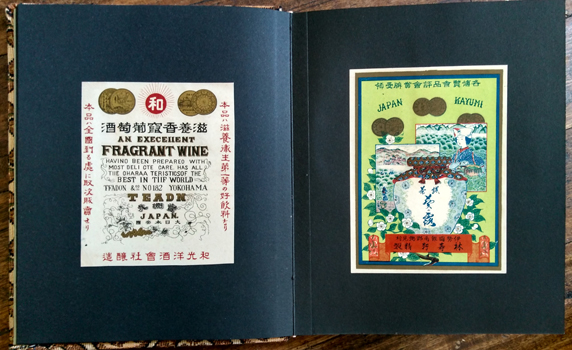
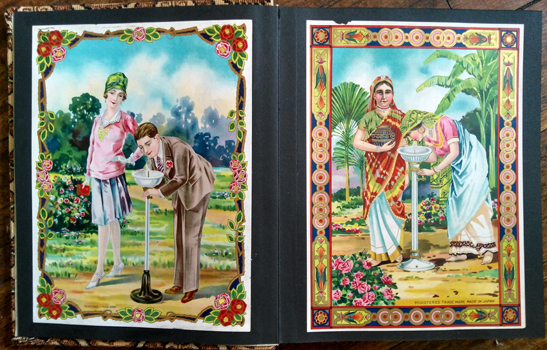
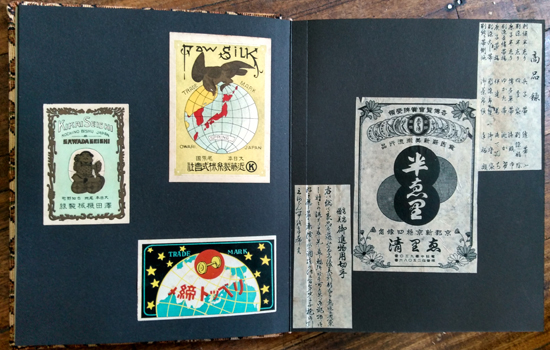
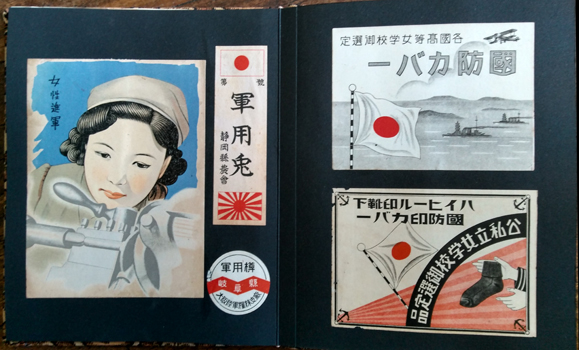

Advertising & trade marks. A Japanese album of labels, trade marks, etc. n.p. early to mid c20th. 29x24cm cross stitch cloth album with 73 examples mounted on 24 black card leaves. Collector's ex libris stamp with the name 'Nanbu' on the front endpaper. Au$400
A carefully collected and presented gathering of labels, wrappers and similar trade mark advertising ephemera - from translucent tissue to stiff card - dating from early in the century into the 1930s.
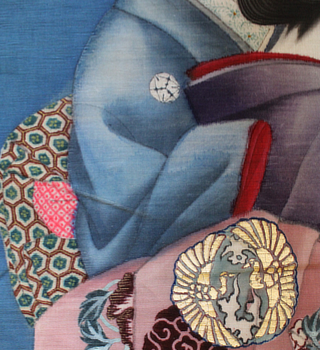
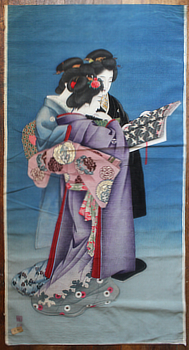
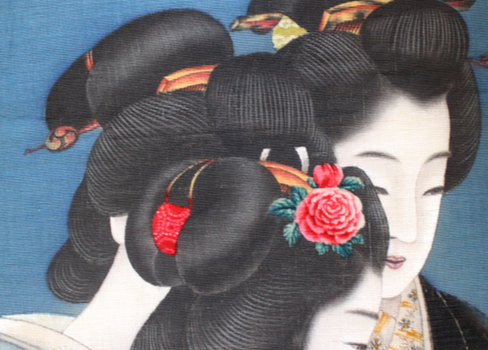


Kimono textile advertisement. Large painted advertisement on linen for a kimono textile merchant. n.p. [earlyish 20th century?]. 137x72cm painting on linen. Au$500
This extravagant promotional piece shows three exquisitely dressed and coiffed ladies considering a length of fabric. The woman with her back to us is undoubtedly the crucial judge.
I hope my photos convey some of the extraordinary detail: from the hair to the gold embroidery to the red thread that holds the bolt of cloth together. What I can't capture properly is the textures that have been mysteriously imbued into what is a heavy linen. That purple kimono feels like velvet, while next to it the horizontal ribbing is accentuated. If a ground has been applied it's microscopically thin. Has some additive to the colour softened and smoothed the fabric?
The upper seal in the bottom left corner includes 'Yamada' but I'm lost after that. I think the lower seal can translate as 'mountain spirit'. Artist's name or establishment? I don't know. Any actual knowledge gratefully accepted.
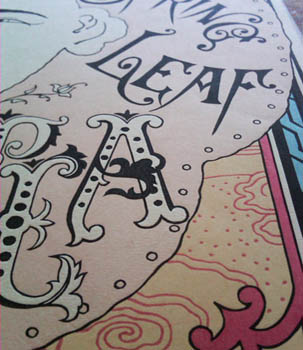


Specimen Tea Label. Smile Extra Choicest Spring Leaf Japan Tea. n.p. n.d. (early c20th?) Colour woodcut 39x34cm. An outstanding, crisply impressed copy. Au$425
A fabulous and puzzling large label - ranji - for export tea chests that would do any sixties' album cover proud. I have learnt that woodcut printing survived for tea labels after other printing went litho because exporters didn't want the ink smell contaminating their tea. Printing quality was high, this was international advertising, but the labels that survive are of course remainders or samples. I take this to be a sample - the paper is good quality and heavy and the printing immaculate - for a label maybe never used. I have looked through hundreds of labels online without finding any Smile Tea. Can an expert put me straight?
This has what a label needs: bright colours, bold contrast, lively typography and an arresting design. But it doesn't have what other tea labels have: a pretty picture that foreigners will immediately recognise as Japan. No elaborately kimonoed beauty, no Fuji, no lucky god. No kimonoed beauty on a tea plantation terrace with a lucky god in attendance and Fuji in the distance. What we have is a happy but somehow sinister character.
With those ears he is surely a wrestler. But bald? Was there a happy bald wrestler famous enough in Japan that someone thought he might translate to the outside world? An ex-wrestler who became famous as the eternally cheerful muscle for the mob?
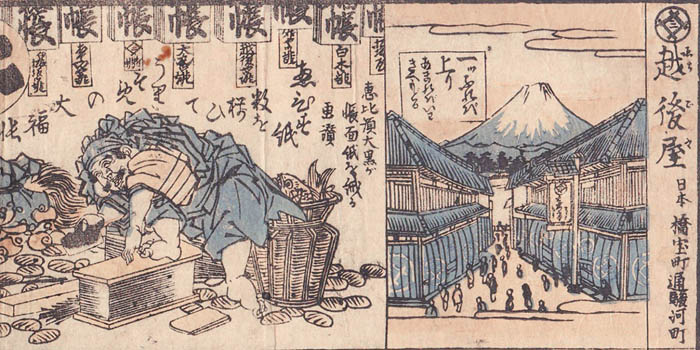
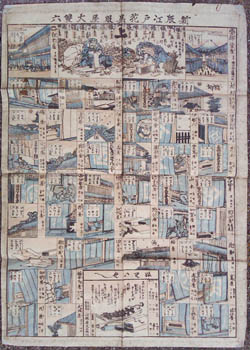
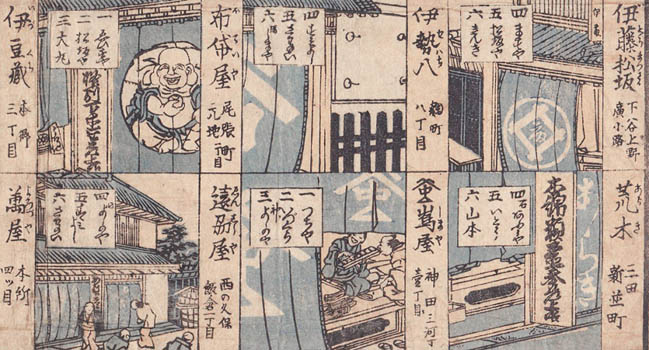
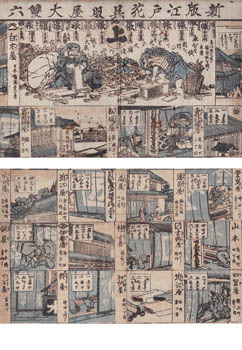

Ikeda Eisen [aka Keisei Eisen]. [Shinpan Edo no Hana Gofukuya Sugoroku] [Tokyo], Yamashiroya Matabe [1820 - 1850?]. Woodblock print 67x46cm, printed in black, blue and pink; folded. Smudges and soiling, a couple of small chips from the top edge. A pretty decent copy. Au$1250
Another lesson, if we need it, that the Japanese had connected and mastered the important stuff of life long before the rest of us: advertising, fun and shopping. In this sugoroku - a racing game - Eisen takes us through the most prestigious dry goods stores and drapers - ie high fashion - of Edo (Tokyo) until we reach Ebisu and Daikokuten - gods, respectively, of merchants and wealth. In other words, who isn't this game for?
Every working Edo inhabitant with a speck of ambition will want a place among the great merchants, rubbing shoulders with such gods while their wealthy patrons have confirmed that their shopping habits are blessed by the gods. The titans of fashionable commerce here include Echigoya (now Mitsukoshi), Shirokiya (which lasted some three hundred years, its ghost is a department store in Honolulu), Iwaki Sotoya, Matsuzakaya (still going), Ebisuya, Daimaru (still going), Shimaya, Sawanoi and Izukura.
Eisen did more than one sugoroku: this; one of more prosaic sights of Edo; one of the Tokaido road; and an elaborate sort of fourth one - the set of courtesan prints which together form a game - are the ones I've traced. I've found two other copies of this shopping adventure, in the UC Berkeley library and in the fabulous sugoroku collection of the Edo Tokyo Museum. They are printed in yellow rather than blue.
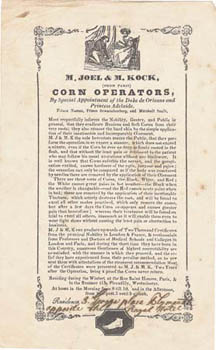
Advertising - Feet. M. Joel & M. Kock, (from Paris) Corn Operators, by Special Appointment to the Duke de Orleans and Princess Adelaide, Prince Nassau ... most respectfully informs the Nobility, Gentry and Public in general, that they eradicate Bunions and Soft Corns from their very roots; ... n.p. [c1830?]. Single sheet (220x140mm); text printed in a decorative border with a cut of a corn operator at work at the top and a bare foot at the bottom. A couple of spots but pretty good. Au$125
Messieurs Joel and Kock normally spent their winters in Paris and summers in London but here their residence has been filled in by hand as 3 George Place, Plymouth, opposite the Royal Hotel.
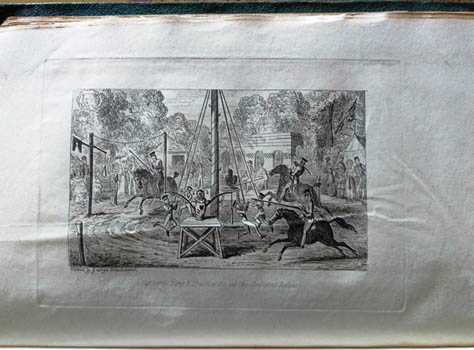
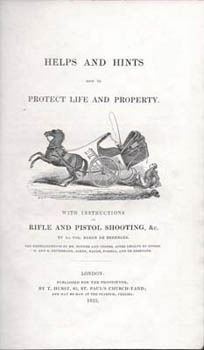


De BERENGER, Lt. Col. Baron [Charles Random]. Helps and Hints How to Protect Life and Property. With instructions in rifle and pistol shooting. &c. London, for the Proprietor by Hurst 1835. Octavo publisher's green grained cloth (rebacked with the original spine preserved); viii,286,[2]pp, two folding lithograph views, eight etched plates by George or Robert Cruikshank, wood engravings through the text. A leaf torn without loss, a little browning of the lithographs, the rebacking perhaps a bit thorough but a rather good copy in a modern cloth slipcase. Au$450
How not to leave a bank; how to deal with footpads, whether on foot or in a carriage; and countless other useful tips on how to survive in London, on the highway and in the country (''eject out of a room, how to, anyone with certainty'' surely works in town or country). The last 30 some pages, which includes the etchings and lithographs, is an advertisement for de Berenger's Stadium, or British National Arena which covered 24 acres of Chelsea.
The Baron de Berenger, or Charles Random, who has been described variously as an inventor, sharpshooter, print colourer and stockmarket fraud, set up his Stadium in 1831 and held modern Olympics there in 1832 and 1838. He certainly had no claim to the rank of Lt. Colonel but there is some uncertainty about his claim to his title; it may have some validity.
The Cruikshank brothers seem to have had a closer relationship with Berenger than mere hired illustrators: Arthur G. Credland, in an article on Berenger in 'Arms & Armour' (2006), speculates that through their keen interest in archery and shooting that one, or both of them, taught at the Stadium and he recounts a less than illustrious heritage for Berenger transmitted via the Cruikshanks.
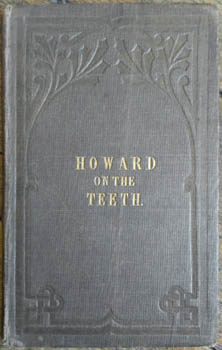
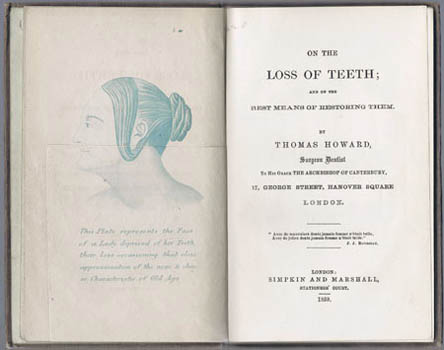

HOWARD, Thomas. On the Loss of the Teeth; and on the best means of restoring them. London, Simpkin & Marshall 1859. Small slender octavo publisher's blindstamped cloth; 62,[1]pp and a charming frontispiece printed in blue with a before and after overlay. An over possessive medico's bookplate and blindstamp on the front endpapers, rather a good copy. Au$200
A successful little book it seems, there were several printings between 1852 and 1862 (the publishers claim 27 by 1857). Howard, surgeon dentist to the Archbishop of Canterbury, at first seems to approve of artificial teeth made of hippo tusk but later points out that they don't last long. There are similar problems with ivory, gold and natural teeth (recycled from other mouths) which understandably disturb persons of "extreme sensibility and delicacy of feeling". He has, though, invented a "new description of composition teeth" which are "perfectly incorruptible" - their "durability is unbounded".
By 1863 Howard had moved from Hanover Square to Fleet Street and extended his hours from 11 till 4 to 10 till 5. Whether this means a thriving business or desperate decline I can't tell.
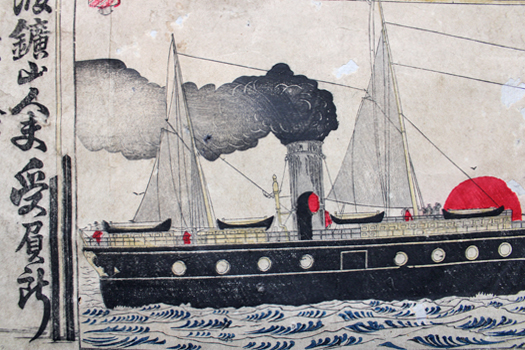
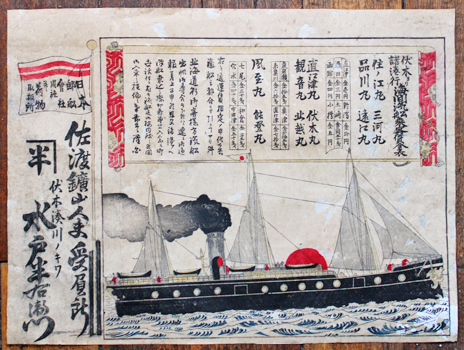
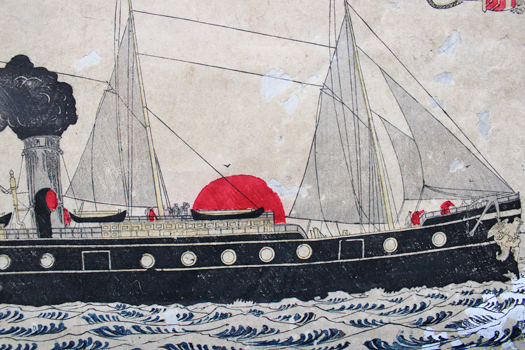
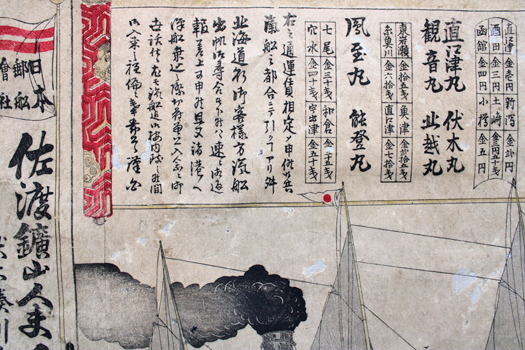

Hikifuda : NYK Line [Fushikiminato-gawa Nokiwa Mito Han Uemon]. n.p. [187-?]. 36x49cm colour woodcut. Bug chewed and carefully repaired, either some time ago or done using old paper. Au$200
This large and still quite handsome steamship advertises ships, routes and fares from Fushikiminato, now part of Takaoka City. Takaoka Museum illustrates their copy online and it is just as chomped as this one.

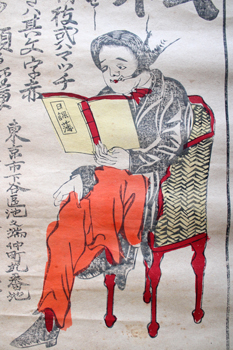
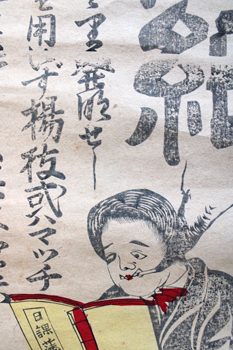
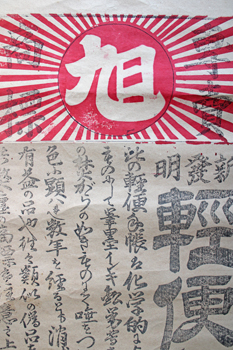

Paper. Toyosha? [Shin Hatsumei Keibenshi]. n.p. [Osaka?] [188-?]. 75x28cm woodcut with added colours. Piece from the top margin well away from the printing, a repaired tear; Quite good for a cheap, vulnerable bit of production. Au$150
I believe this to be an announcement for a new invention of a lightweight paper. I hope not the paper this is printed on which seems heavy and coarse to me. Probably not considering the easy grasp of our newspaper addict. I suspect the cigarettes will stay on that side of his mouth until his left eye looks as sore as the right does now. Then he will switch back.
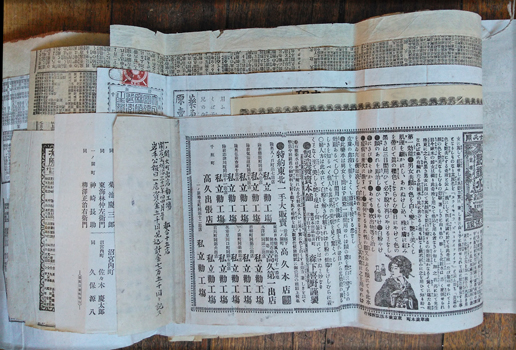
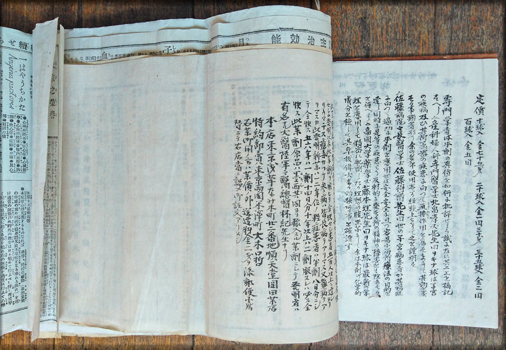
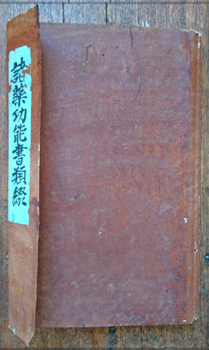
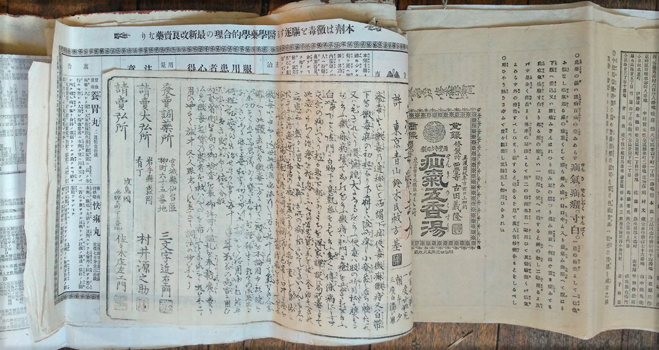

Patent remedies. [cover title]. A gathering of 19th century handbills or descriptive and instructive leaflets or wrappers for various patent, herbal or quack medicines. v.p. c1880 to c1900? 26 individual pieces bound to fold into a handmade board and stiff paper wallet style string tied binding, 28x18cm, treated with persimmon, hand lettered title piece. Some are quite large, some are printed on both sides and a few are woodcut. Au$1500
The work of the sort of collector who deserves a small shrine. Here have been carefully preserved the most disposable, awkwardly shaped and ephemeral records of a recondite corner in modern history: when drugs and cures became an industry.
At least one of these brands is still available: Chujoto for "Female Complaints" still alleviates menstrual pain. There may be others and I'll bet many are the foundations of current industrial giants. The only date I've spotted is Meiji 13 - 1880; Chujoto was apparently invented in 1893 (or by princess Chujo of the Fujiwara clan in a Snow White like tale) and some may be a little earlier or later.
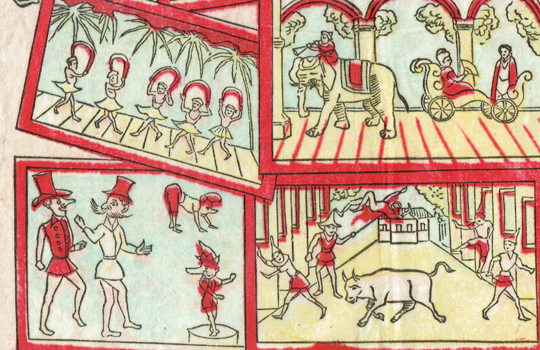
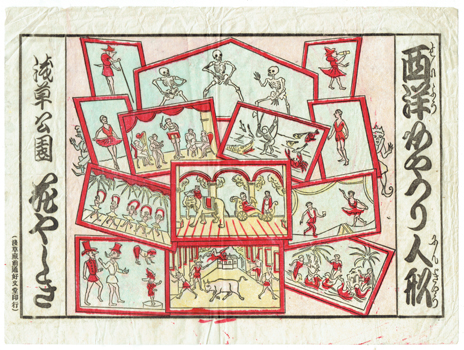
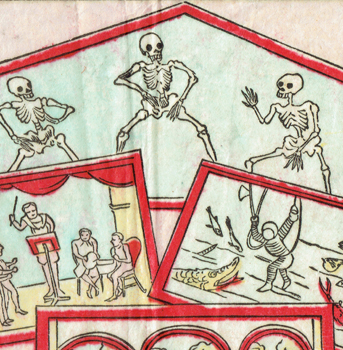

Puppets. [Seiyo Ayatsuri Ningyo]. Tokyo, Hanayashiki [188-?]. Woodcut on translucent paper with added colours, 25x19cm. Old fold, rumpled; rather good. Au$300
This hikifuda or flyer for the western puppet show in Asakusa Park's Hanyashiti - amusement park - exists in two forms: one with the main title across the top and the other in the right column, as here. The illustrations are the same. The Tokyo Museum has a copy of this and Waseda a copy of the other; I can't find one outside of Japan.
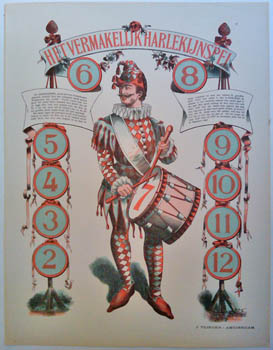
Paper Game. Het Vermakelijk Harlekijnspel. Amsterdam, J. Viegler [188-?]. 57x43cm colour litho game on paper. A rather good copy. Au$75
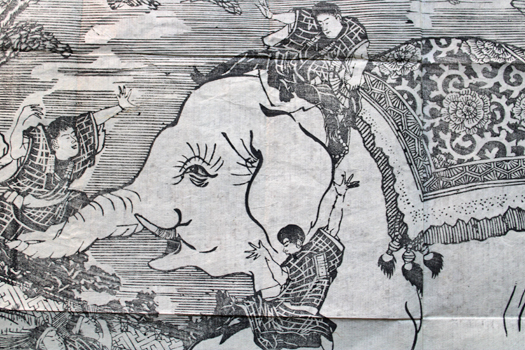
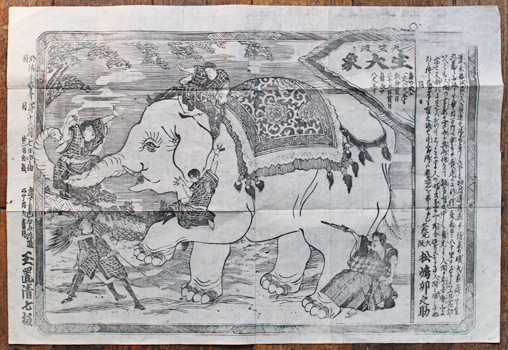
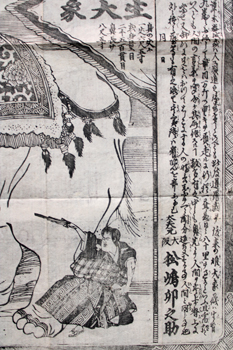
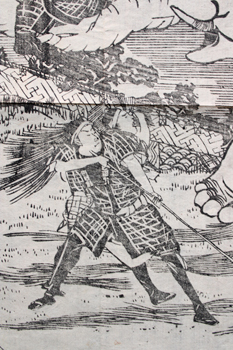

Elephant advertisement. : [Tenjiku Watari : Nama Daizo]. Osaka, Tamaki Seishichi 1883 (Meiji 16) Woodcut broadside 37x55cm. Rather good. Au$650
A kawaraban style advertisement for the great elephant show and a higher class - and grander - bit of art than the ones produced in Yokohama that I've seen, one dated 1875 and one 1883.
1863 was the year of the elephant in Japan, the great Indian elephant drew squillions of spectators and artists and printmakers went crazy. It wasn't the first elephant to arrive in Japan but it had been near 150 years since the last one. Apparently Raffles sent one in 1808 as a deal sweetener but it was refused and expelled - with a hundred bales of wheat from the shogun for the return journey. Just as well, while elephants had been celebrated in art for centuries, elephants in person didn't have long happy lives in Japan.
The 1863 elephant went on tour after a spell in Tokyo but is our elephant the same one? Is it the same elephant who starred in Yokohama which, according to the unreliable and incongruent ages given on different prints, was too young? Certainly our elephant has progressed from being a drawcard by merely existing to being the star of a theatrical show.
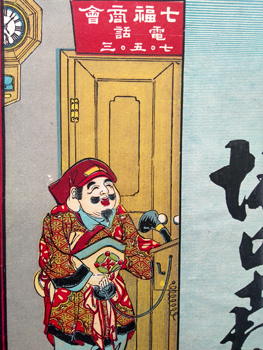

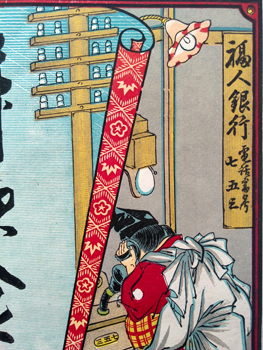

Telephone hikifuda. Hikifuda with lucky gods Ebisu and Daikokuten on the telephone. n.p. [Osaka? 189-?] Colour woodcut 26x38cm. A crooked fold and a few small marks; quite good and bright. Au$300
Ebisu and Daikokuten did embrace modernity - or rather, wanted to play with every new gadget and fashion - so naturally they would want to play on the telephone. Surely they had plenty of spirit messengers among their retinues. Apparently public telephones only became available in 1890, until then they were reserved for the government, police and select companies.
I can't read the centre panel which tells us who was selling what and I don't understand the signifance of 753 which is the number in both telephone booths and the banner on the right. Something to do with Shichi-Go-San? November 15? Sorry. But there would be no point to this hikifuda unless it was timely, that telephones were brand new, in the same way that this pair were pioneer joyriders in a motor car and donned military uniforms during the Russo-Japanese war.
Hikifuda - small posters or handbills - were usually produced with the text panel blank. The customer, usually a retailer, had their own details over printed, so the same image might sell fine silk or soy sauce.
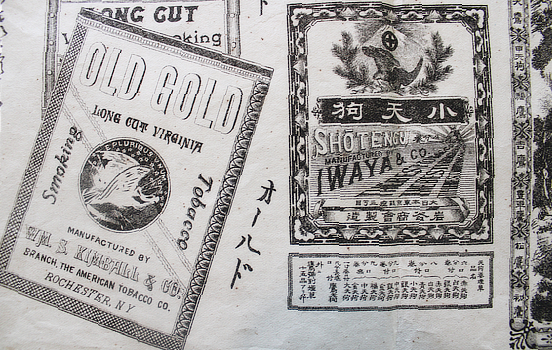
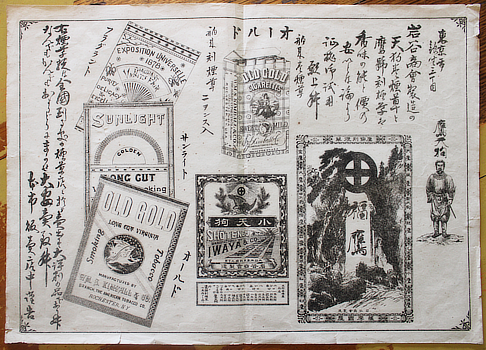
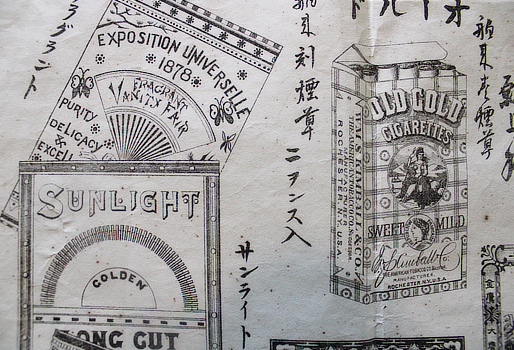

Tobacco hikifuda. Iwaya & Co. Hikifuda by Iwaya & Co for their Shotengu cigarettes and other brands from American manufacturers Wm. S. Kimball and S.F. Hess Tokyo? Iwaya c1890? 27x38cm illustrated lithograph. Folded and frayed around the edges; pretty decent. Au$100
Iwaya Matsuhei was a promoter's promoter. After a few false starts - the odd incendiary rebellion, lawsuit and bankruptcy - he got into tobacco in the 1880s. Importing and learning from American companies like Kimball and manufacturing his own Tengu cigarettes from about 1884. He was soon a flamboyant plutocrat about town, bannering how much tax he paid and how many charity workers he supported (a lot). Soon came the great Tobacco Advertising War between Iwaya and his rival Murai Kichibei.
This restrained hikifuda, which features more of Iwaya's imports than his own brands must come early in the history. Shotengu - small Tengu - was only one of a panoply of Tengu cigarettes - large Tengu, medium, gold Tengu, silver Tengu ... through to happy nation Tengu.
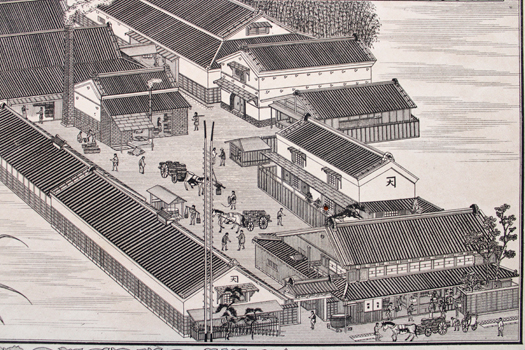
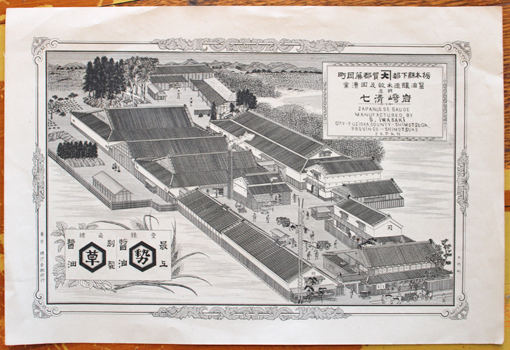
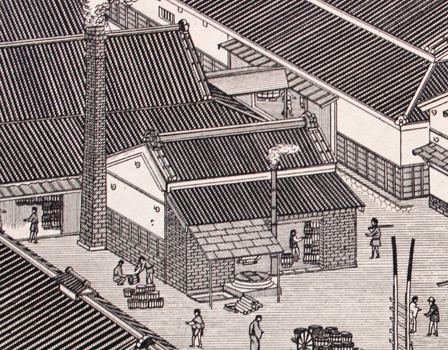

Hikifuda. Iwasaki Seishichi : Japanuese Sauce Manufactured by S. Iwasaki City - Fujioka, County - Shimotsuga, Province - Shimotsuke Japan [sic]. Tokyo [189-?]. 22x33cm lithograph. Au$100
A handsome birds-eye of the soy sauce works. The company still exists as a maker and seller of horse food, something of a come down since Iwasaki's glory days as a magnate and most important person. This view comes early in his career after he had taken over the family business and before he made two fortunes from the Sino-Japanese and Russo-Japanese wars. He was outraged by the profiteering control ordinance passed during WWI and seems to have had some part in having it suspended.
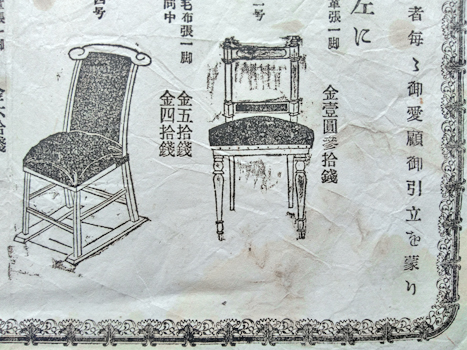
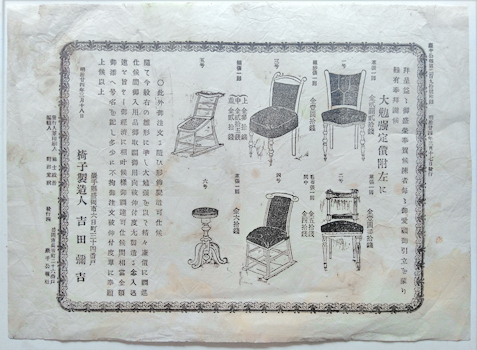
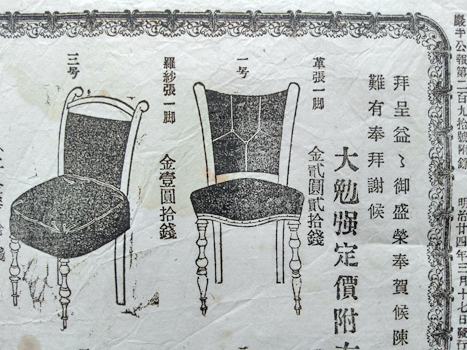
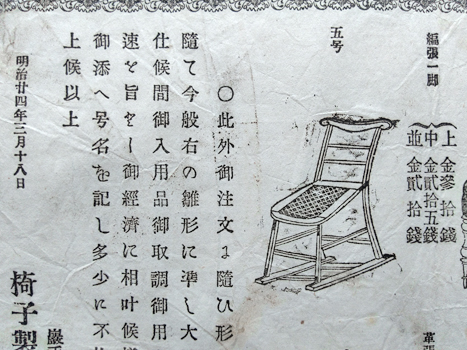

Hikifuda. Chairs. Yoshida Yakichi. [Isu Seizojin]. Morioka (Iwate) 1891 (Meiji 24). Letterpress broadside 24x33cm; five chairs and a stool illustrated. Top corners repaired - I suspect it was in an album, mildly stained; pretty good. Au$375
Advertising handbill for Yoshida Yakichi, a furniture, or at least chair, maker in Morioka - in northern Honshu.
Maruya opened probably the first western furniture shop in Japan in the Ginza in 1872, probably selling imports to begin with. How quickly western furniture making for a Japanese market followed I don't know. The wealthy who wanted at least one western room to show off their modernity would likewise want to show off fine imported pieces. I'm sure there is a learned paper somewhere on western furniture making in c19th provincial Japan. If there isn't, here's a good place to start.
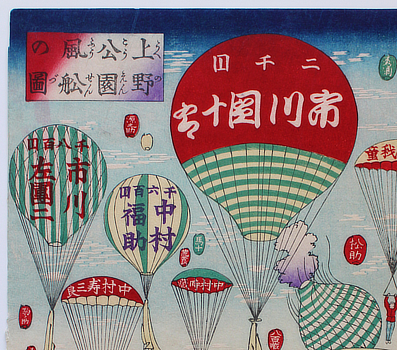

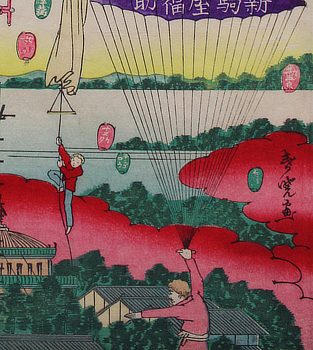
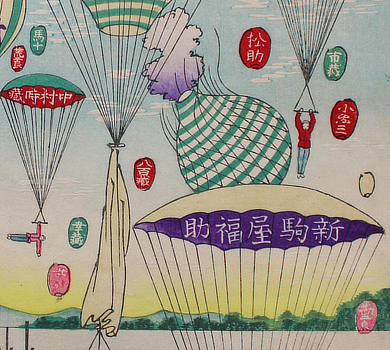

Kobayashi Ikuhide. [Uenokoen F sen no Zu]. Tokyo, Sakai Kinzaburo, January1891 (Meiji 24). Colour woodcut 36x24cm. At sometime mounted on tissue with what was probably a hinge on the right edge. A nice bright copy. Au$1150
The brightest, busiest and most impossible of the Ueno Park balloon prints. Aeronaut Percival Spencer, of the Spencer aeronautic dynasty, came to Japan in 1890 with his balloons and parachutes, performing his balloon ascent and parachute descent stunts in Yokohama and in Ueno Park in Tokyo in November 1890. He is said to have injured himself slightly having to avoid the royal tent during a command performance. Tokyo went balloon mad - again, they had a craze years earlier - and Spencer's performance was made into a Kabuki dance play - Fusen Nori Uwasa Takadono (Riding the Famous Hot-Air Balloon, see Brandon; Kabuki Plays on Stage) by premier dramatist Kawatake Mokuami - which ran for a month in early 1891. The Kabuki star Kikugoro V (who played the demon princess in the 1899 film Momijigari) played Spencer with waxed moustache, hat and learnt a short speech in English for the finale.
I think all the other balloon prints of Spencer in action are actually Kikugoro in action and this fantasia is also a theatre print: those are actors' names on the balloons. We might think of this as an advertisement for the play that had begun, or was about to begin, its run. But front and centre is the name of Ichikawa Danjuro, who shared the top rung of the star ladder - but not this play - with Kikugoro and I can't see Kikugoro's name anywhere.
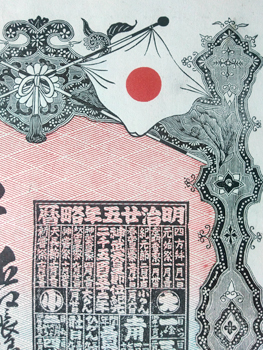

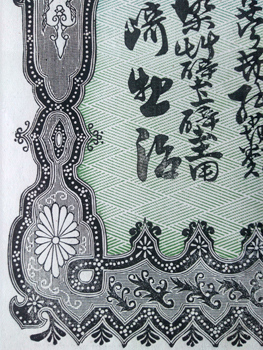

Hikifuda. ... [Yamaishihara ...] Osaka 1891 (Meiji 24). Colour woodcut 38x26cm. Two horizontal folds, a nice copy. Au$100
An example of a somewhat western aesthetic style (ie inspired by Japan) applied to the authoritive detail of a currency note or share certificate. In other words, here is a company or product to be trusted. Absolutely.
Hikifuda - small posters or handbills - were usually produced with the text panel blank. The customer, usually a retailer, had their own details over printed, so the same image might sell fine silk or soy sauce.
Yamaishihara is an area south west of Osaka and the timetable is for 1892. The rest is up to you.
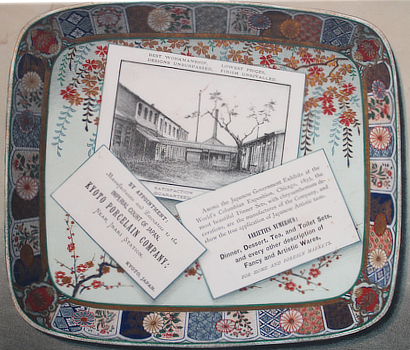
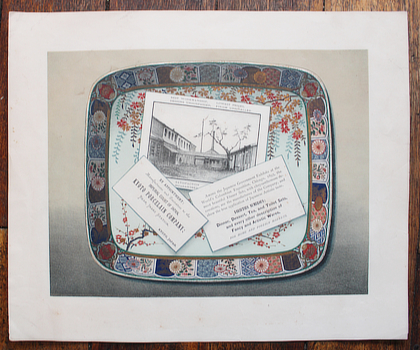

Kyoto Porcelain Company. A chomolithograph advertisement for the Chicago Columbian Exposition 1893. n.p. [1893]. 33x40cm chomolithograph. Short tear in a blank margin, a few small marks; quite good. Au$125
A handsome production, as it should be from Manufacturers and Decoraters to the Imperial Court of Japan.
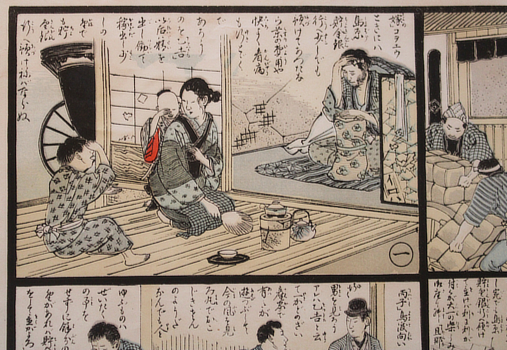
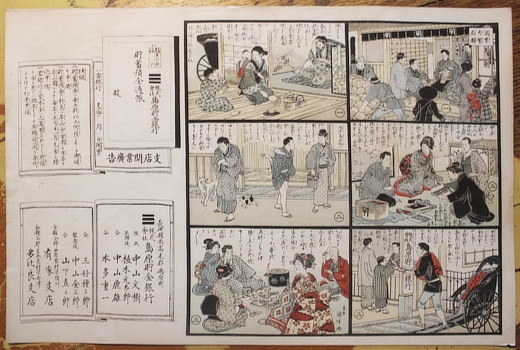
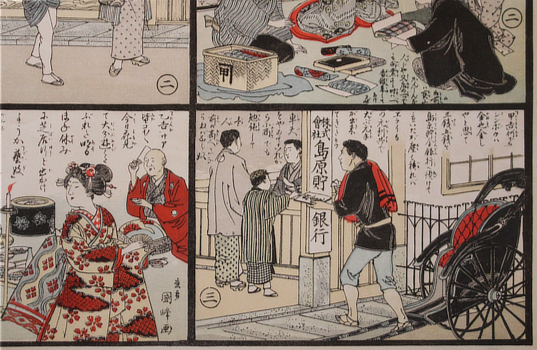
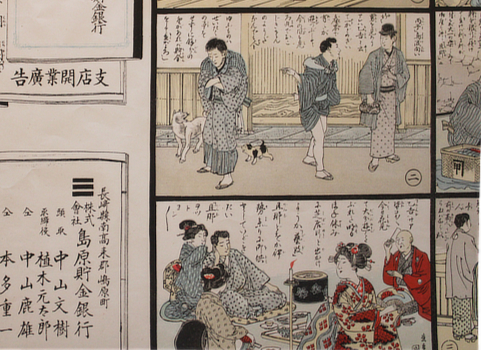

Banking. : [Kabushikigaisha Shimabara Chokinginko : Shiten Kaigyo Kokoku]. n.p. [c1898] Colour lithograph 26x39cm. A nice copy. Au$300
This gentle, charming advertisement - hikifuda - announcing branch openings of the Shimabara Savings Bank is illustrated by two reassuring stories of rags to riches - or solid comfort at least. The Shimabara Bank was founded in 1891 and the Shimabara Savings Bank in 1897 but didn't live long thanks to some investment decisions by the Nakayama family - three Nakayamas including president Fumiko are listed among the directors.
Shimabara is in the Nagasaki prefecture and the two branches advertised are Arie - a town that was engulfed by Minamitakaki City - and Taira - which I can only trace as a railway station in a desolate looking area of Unzen, Nagasaki. Dates for month and day have been left blank.
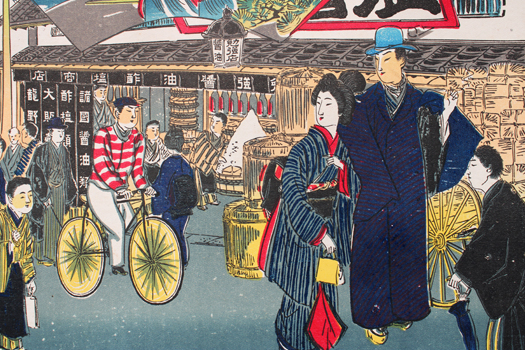
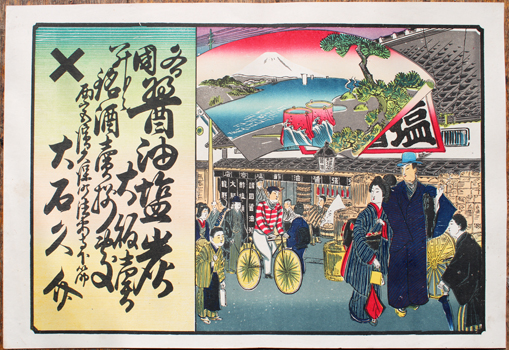
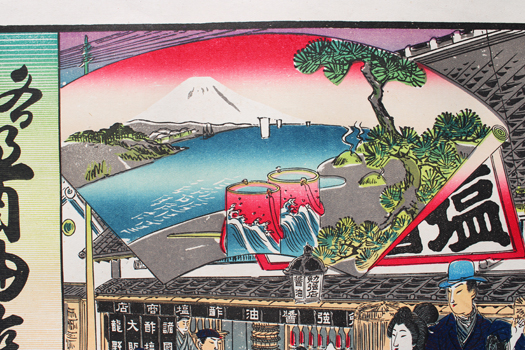

Hikifuda. ... [Shoyu Shio Sumi ...] np [190-?]. Colour lithograph 25x37cm. Pretty good. Au$150
An almost average street scene in late Meiji Japan but: without the telegraph poles and power lines, bowler hats and cyclist it could be a street scene generations earlier.
Hikifuda - small posters or handbills often handed out as seasonal gifts - were usually produced with the text panel blank. The customer, usually a retailer, had their own details over printed, so the same image might sell fine silk or soy sauce. This one, from a Nishinomiya (between Osaka and Kobe) dealer, indeed sells soy sauce, salt, sake and charcoal - tradition kept alive in the modern world.

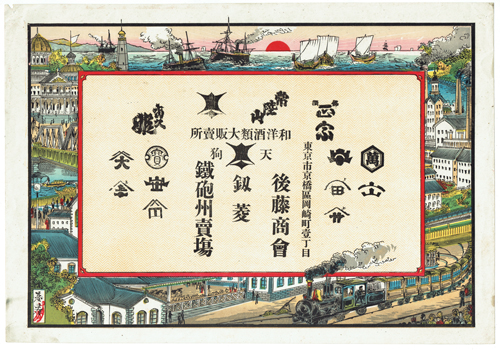
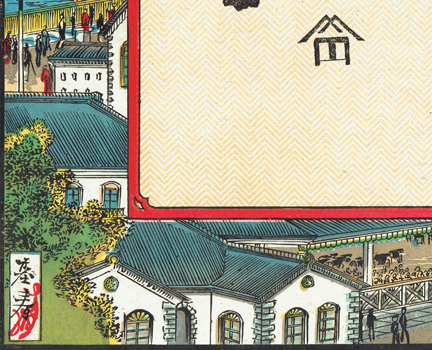
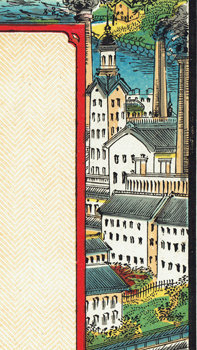

Hikifuda. [Goto Shokai]. n.p. [c1900] 26x38cm colour woodcut. Small knick from a top corner; a nice copy. Au$135
Bustling modern Japan is celebrated in this advertisement for the Japanese and western liquor merchants Goto Shokai. I presume it's the trademarks of the brands they handle that are displayed.
These hikifuda - small posters or handbills - were usually produced with the text panel blank. The customer, usually a retailer, had their own details over printed, so the same image might sell fine silk or soy sauce.
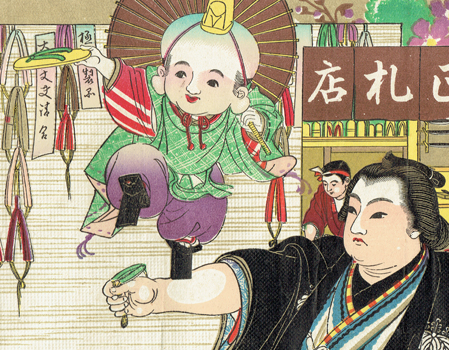
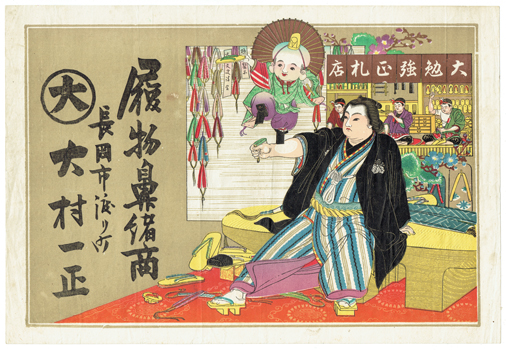
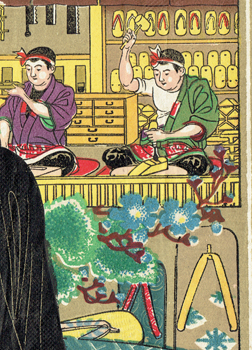
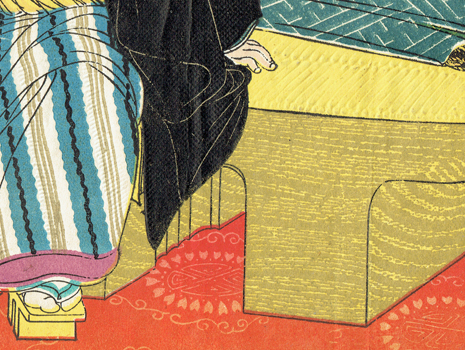

Hikifuda. Shoes. ... [Hakimono Hanao-sho .... Omura Kazumasa]. n.p. [190-?]. 26x38cm colour woodcut. Au$200
I guess that if a strapping sumo wrestler chooses to wear your shoes you know they must be sturdy. I guess the pint-size deity dancing on hs arm is a fukusuke but I don't get the connection, the significance of the hat, and neither do I know who he - the wrestler - is. I suspect that this is a celebrity portrait rather than a generic figure and I bet someone out there can identify both of them.
These hikifuda - small posters or handbills - were usually produced with the text panel blank. The customer, usually a retailer, had their own details over printed, so the same image might sell fine silk or soy sauce. That doesn't apply here.
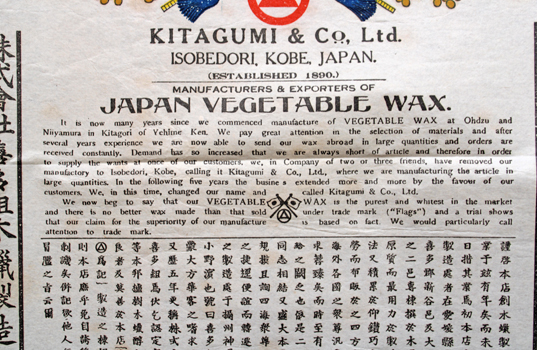


Wax. Kitagumi & Co. Ltd. Kobe. Manufacturers & Exporters of Japan Vegetable Wax ... Kitagumi [190-?]. 38x51cm printed broadside in English and Japanese within a colour border. Au$75
A dignified but not unfriendly advertisement - or perhaps a label or wrapper for export - befitting the purest and whitest wax in the market. Company founder Kochi Torajiro must have used squillions of what he made from wax to build the Garyu-sanso, maybe the most understated, modest showoff piece of design and craftsmanship ever.
[1] 2 3 4   |